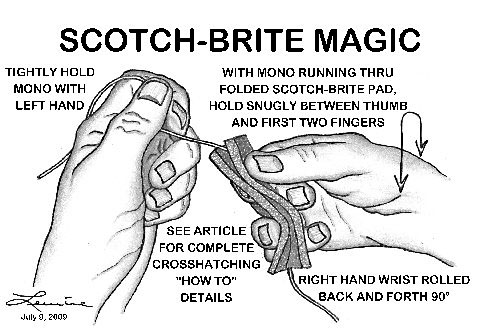
The Saltwater Magazine for Gulf Coast Fishing!
FISHING FORECASTS
| FISHING CALENDARS | ARTICLES | ADVERTISE
| SUBSCRIBE
Search Gulf Coast Fisherman's
Web Site
Past articles, specific
places or fish, etc.

Scotch-Brite Magic
Camo Technique for Fishing Line
by Patrick Lemire
| CURRENT
MOON lunar phases |

Scotch-Brite Magic - It's not really about a magic pad, but the results of using one to create a crosshatch pattern on monofilament's surface is sort of magical. I came up with this mono crosshatch idea about twelve years ago and have been using it ever since.
- My idea was generated after I saw an underwater photo of a hooked ling on a mono leader, taken a foot or so below the surface the mono leader was shining in the reflected, magnified sunlight as if it were chrome. While that was extreme, it did bring out the apparent fact that, even though a mono leader might be clear, its smooth surface greatly contributed to it being a sunlight reflector. The most common viewing of this "chrome mono" look is when the sunlight is coming from above to almost directly behind a mono strand and into the water.
- Think about how many times
this has probably happened in the past. Killing the reflection on a mono
main line for about 5-6 feet above a wire leader helps too, especially
when a short leader of around twelve inches is used.
- The idea of a crosshatch pattern on the mono's surface greatly reducing the reflection was a good one; how to get it there was the next problem. Somewhere in the thought process of solving the reflection problem, I came up with using fine grit wet/dry sandpaper. This sort of worked, but still was not what I was looking for.
- When looking at a scouring pad the "light bulb came on." After trying several brands and types of pads, I settled on the dark green ones by 3-M, named Scotch-Brite. They had the flexibility, softness and texture that gave the best and most consistent crosshatch pattern on a mono strand's surface. The last time I bought any of these pads was at Sam's, a Value Pack of 18. When each pad was cut into four equal pieces, this gave me a total of 72, measuring about 4-1/2" x 3" .
- The mono surface crosshatching process goes like this: Hold one end of the mono section to be modified in your left hand. Hold the other end in a Scotch-brite pad in your right hand, that's up against your left hand. Now, with a back and forth wrist rolling motion of about one second each, pull the mono slowly through the pad at about 6" per second with your right hand. See the illustration. When you get to the distance along the mono to be crosshatched, stop and reverse the process until you reach the original starting point. One time up, one time down the mono and you have put a crosshatch pattern on the mono surface.
- Breaking up the mono's reflective surface must be done with a crosshatch pattern, just pulling a mono strand straight through a pad will only put those minute scratches in a straight line, the reflected shine will still be a problem, in fact, intensified.
- To see the effect of this cross-hatching, using great care, fill a clear glass container with clear water, put it in a position so that direct sunlight is coming through from the side away from you. Put a loop of crosshatched mono and a loop from the same spool without the treatment into the jar's water. The mono loop with the crosshatch pattern will almost disappear, versus the unaltered piece.
- You will have no question as to the effectiveness of the crosshatching. The benefit of this crosshatching is that it's headed in the direction of having stealth performance as with fluorocarbon. You retain the flexibility and knot strength of mono, while gaining near invisibility in the water. Other fluorocarbon problem areas eliminated are the reported questionable knot strength and stiffness of some, plus its higher cost. At about six dollars for that pack of Scotch-Brite pads, plus a little time and effort, this crosshatching is a definite fishing tackle bargain.
- Does this crosshatching weaken the mono? Infinitesimally is the word that comes to mind when I'm asked that question. The one effect that is a minus will come into view after it's fished a day or two; the disturbed surface might turn a bit cloudy. Change the leader or cut the cloudy portion off. All of the reels I use offshore have Spectra on them and about fifteen feet of 80 lb. mono leader tied on by knot.
- The reflection reducing, stealth effect of crosshatching is of greatest benefit from near the surface to about 8-10 ft. down in clear water, when viewed from near horizontal. This beneficial effect also comes into play at night around a brightly lit production platform far offshore think tuna fishing.
- This is another of those instances where adapting a product to a nonrelated use results in a tried and proven new technique - you never know where you will make your next fishing tackle find. Using a scouring pad to create a low cost monofilament alternative to fluorocarbon while keeping mono's basic characteristic - it's Scotch-Brite Magic!
[ Articles | Home | More Rod 'n Reelin' ]

